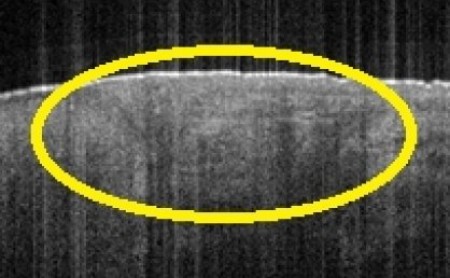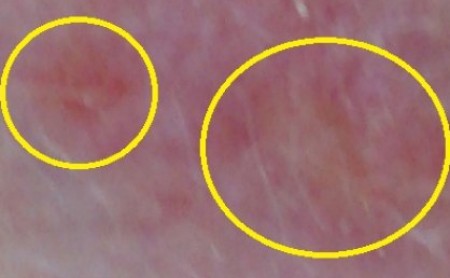Was sind Aktinische Keratosen?
Aktinische Keratosen (AK) sind eine der häufigsten Erkrankungen an der Haut älterer Menschen. Die Prävalenz dieser Keratosen steigt mit steigenden Lebensalter, und der damit einher gehenden Belastung mit UV-Strahlen, der allgemeinen Exposition zur Sonne, sowie des Hauttyps (1.) Weitere Steigerung der Prävalenz wird erwartet, da sich das Schönheitsideal sowie das Freizeitverhalten der Menschen in den letzten Jahrzehnten („gesunde Bräune“, Sonnen, Solarstudios) geändert hat, und die steigende Lebenserwartung im allgemeinen zu einer Zunahme der kumulativen UV-Exposition führt.
In Australien leiden bereits bis zu 60% der kaukasisch-stämmigen Bevölkerung über 40 Jahren an AK. (2.)
In Australien leiden bereits bis zu 60% der kaukasisch-stämmigen Bevölkerung über 40 Jahren an AK. (2.)

Daraus resultiert ein hoher Behandlungsbedarf, da es sich bei der Aktinischen Keratose um eine Präkanzerose zum invasiven Plattenepithelkarzinom oder Spinozellulärem Karzinom handelt.

Dieses kann dann metastasieren, woraus dann eine relativ niedrige 5-Jahres-Überlebensrate von 25-30% resultiert. (3.,4.,5.) Das Risiko, dass eine AK sich zu Plattenepithelkarzinomen entwickeln liegt bei etwa 10%, wobei das Risiko sich bei multiplen Aktinischen Keratosen dementsprechend erhöht.
Bisherige Behandlungsansätze umfassen topisch 5-Flour-Uracil (verschiedene Konzentrationen möglich) oder Imiquimod (immunmodulierend) (6.,7.,8.), Kryotherapie (9.), Excision (Shave, Kürrettage, Lokale Excision), Photodynamische Therapie (PDT) (10.), klassische Dermabrasion (11.), sowie Laser-Resurfacing (12.).
Bisherige Behandlungsansätze umfassen topisch 5-Flour-Uracil (verschiedene Konzentrationen möglich) oder Imiquimod (immunmodulierend) (6.,7.,8.), Kryotherapie (9.), Excision (Shave, Kürrettage, Lokale Excision), Photodynamische Therapie (PDT) (10.), klassische Dermabrasion (11.), sowie Laser-Resurfacing (12.).
Quellen
1. Leffell DJ. The scientific basis of skin cancer. J Am Acad Dermatol. Jan 2000;42(1 Pt 2):18-22.
2. Frost CA, Green AC. Epidemiology of solar keratoses. Br J Dermatol. Oct 1994;131(4):455-64.
3. Rowe DE, Carroll RJ, Day CL Jr. Prognostic factors for local recurrence, metastasis, and survival rates in squamous cell carcinoma of the skin, ear, and lip. Implications for treatment modality selection. J Am Acad Dermatol. Jun 1992;26(6):976-90.
4. Gloster HM Jr, Neal K. Skin cancer in skin of color. J Am Acad Dermatol. Nov 2006;55(5):741-60; quiz 761-4.
5. Breuninger, H., Bootz, F., Hauschild, A., Kortmann, R.-D., Wolff, K., Stockfleth, E., Szeimies, M., Rompel, R. and Garbe, C. (2008), Kurzleitlinie – Plattenepithelkarzinom der Haut. JDDG: Journal der Deutschen Dermatologischen Gesellschaft, 6: no. doi: 10.1111/j.1610-0387.2008.06706
6. Drake LA, Ceilley RI, Cornelison RL, et al. Guidelines of care for actinic keratoses. Committee on Guidelines of Care. J Am Acad Dermatol. Jan 1995;32(1):95-8.
7. Tutrone WD, Saini R, Caglar S, Weinberg JM, Crespo J. Topical therapy for actinic keratoses, I: 5-Fluorouracil and imiquimod. Cutis. May 2003;71(5):36
8. Gupta AK, Davey V, Mcphail H. Evaluation of the effectiveness of imiquimod and 5-fluorouracil for the treatment of actinic keratosis: Critical review and meta-analysis of efficacy studies. J Cutan Med Surg. Oct 2005;9(5):209-14.
9. Ulrich C, Bichel J, Euvrard S, et al. Topical immunomodulation under systemic immunosuppression: results of a multicentre, randomized, placebo-controlled safety and efficacy study of imiquimod 5% cream for the treatment of actinic keratoses in kidney, heart, and liver transplant patients. Br J Dermatol. Dec 2007;157 Suppl 2:25-31.
10. Thai KE, Fergin P, Freeman M, et al. A prospective study of the use of cryosurgery for the treatment of actinic keratoses. Int J Dermatol. Sep 2004;43(9):687-92.
11. Braathen LR, Szeimies RM, Basset-Seguin N, et al. Guidelines on the use of photodynamic therapy for nonmelanoma skin cancer: an international consensus. International Society for Photodynamic Therapy in Dermatology, 2005. J Am Acad Dermatol. Jan 2007;56(1):125-43.
12. Winton GB, Salasche SJ. Dermabrasion of the scalp as a treatment for actinic damage. J Am Acad Dermatol. Apr 1986;14(4):661-8.
